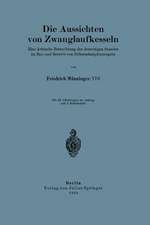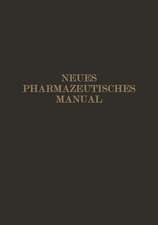Modeling and Control of Antennas and Telescopes: Mechanical Engineering Series
Autor Wodek Gawronskien Limba Engleză Paperback – 19 noi 2010
| Toate formatele și edițiile | Preț | Express |
|---|---|---|
| Paperback (1) | 936.60 lei 6-8 săpt. | |
| Springer Us – 19 noi 2010 | 936.60 lei 6-8 săpt. | |
| Hardback (1) | 942.59 lei 6-8 săpt. | |
| Springer Us – 24 iun 2008 | 942.59 lei 6-8 săpt. |
Din seria Mechanical Engineering Series
-
 Preț: 391.84 lei
Preț: 391.84 lei - 18%
 Preț: 1110.72 lei
Preț: 1110.72 lei - 15%
 Preț: 593.73 lei
Preț: 593.73 lei - 18%
 Preț: 944.99 lei
Preț: 944.99 lei - 15%
 Preț: 653.14 lei
Preț: 653.14 lei - 17%
 Preț: 363.12 lei
Preț: 363.12 lei - 18%
 Preț: 1239.05 lei
Preț: 1239.05 lei - 15%
 Preț: 640.06 lei
Preț: 640.06 lei - 18%
 Preț: 1129.65 lei
Preț: 1129.65 lei - 15%
 Preț: 522.24 lei
Preț: 522.24 lei - 15%
 Preț: 654.77 lei
Preț: 654.77 lei - 15%
 Preț: 643.34 lei
Preț: 643.34 lei - 15%
 Preț: 611.40 lei
Preț: 611.40 lei - 18%
 Preț: 765.96 lei
Preț: 765.96 lei - 20%
 Preț: 631.70 lei
Preț: 631.70 lei - 18%
 Preț: 1009.22 lei
Preț: 1009.22 lei -
 Preț: 418.34 lei
Preț: 418.34 lei - 15%
 Preț: 640.71 lei
Preț: 640.71 lei -
 Preț: 403.53 lei
Preț: 403.53 lei - 18%
 Preț: 813.97 lei
Preț: 813.97 lei - 18%
 Preț: 1386.48 lei
Preț: 1386.48 lei - 18%
 Preț: 951.47 lei
Preț: 951.47 lei - 18%
 Preț: 833.09 lei
Preț: 833.09 lei - 15%
 Preț: 644.49 lei
Preț: 644.49 lei - 18%
 Preț: 941.05 lei
Preț: 941.05 lei - 18%
 Preț: 1386.17 lei
Preț: 1386.17 lei -
 Preț: 399.67 lei
Preț: 399.67 lei - 18%
 Preț: 1389.44 lei
Preț: 1389.44 lei - 18%
 Preț: 790.46 lei
Preț: 790.46 lei - 18%
 Preț: 1388.22 lei
Preț: 1388.22 lei - 18%
 Preț: 1024.53 lei
Preț: 1024.53 lei - 15%
 Preț: 590.16 lei
Preț: 590.16 lei - 18%
 Preț: 1234.00 lei
Preț: 1234.00 lei - 18%
 Preț: 1386.62 lei
Preț: 1386.62 lei - 15%
 Preț: 543.85 lei
Preț: 543.85 lei -
 Preț: 391.61 lei
Preț: 391.61 lei - 18%
 Preț: 944.19 lei
Preț: 944.19 lei - 18%
 Preț: 736.16 lei
Preț: 736.16 lei - 18%
 Preț: 943.88 lei
Preț: 943.88 lei - 15%
 Preț: 693.21 lei
Preț: 693.21 lei - 18%
 Preț: 781.77 lei
Preț: 781.77 lei - 15%
 Preț: 639.08 lei
Preț: 639.08 lei - 23%
 Preț: 737.28 lei
Preț: 737.28 lei - 15%
 Preț: 641.53 lei
Preț: 641.53 lei -
 Preț: 401.42 lei
Preț: 401.42 lei
Preț: 936.60 lei
Preț vechi: 1142.20 lei
-18% Nou
Puncte Express: 1405
Preț estimativ în valută:
179.21€ • 187.12$ • 148.33£
179.21€ • 187.12$ • 148.33£
Carte tipărită la comandă
Livrare economică 05-19 aprilie
Preluare comenzi: 021 569.72.76
Specificații
ISBN-13: 9781441946249
ISBN-10: 1441946241
Pagini: 244
Ilustrații: XVI, 228 p.
Dimensiuni: 155 x 235 x 13 mm
Greutate: 0.35 kg
Ediția:Softcover reprint of hardcover 1st ed. 2008
Editura: Springer Us
Colecția Springer
Seria Mechanical Engineering Series
Locul publicării:New York, NY, United States
ISBN-10: 1441946241
Pagini: 244
Ilustrații: XVI, 228 p.
Dimensiuni: 155 x 235 x 13 mm
Greutate: 0.35 kg
Ediția:Softcover reprint of hardcover 1st ed. 2008
Editura: Springer Us
Colecția Springer
Seria Mechanical Engineering Series
Locul publicării:New York, NY, United States
Public țintă
ResearchCuprins
Modeling.- Analytical Models.- Models from Identification.- Model Reduction.- Wind Disturbance Models.- Control.- Preliminaries to Control.- PI and Feedforward Controllers.- LQG Controller.- H ? Controller.- Single Loop Control.- Non-Linear Control.- RF Beam Control.- Track-Level Compensation.
Recenzii
From the reviews:
"The book presents the author’s research and experience in the area of antenna modeling, dynamics, and control. The analytical approach and the experimental approach to the subject are explained. The text is clearly written up-to-date authoritative reference describing the application part of the antenna control engineering. The monograph is primarily addressed to the antenna, telescope, and radiotelescope engineers, as well as researchers and students in motion control and mechatronics." (Lubomír Bakule, Zentralblatt MATH, Vol. 1159, 2009)
“This book is addressed to engineers and students interested in motion control and primarily to antenna, telescope, and radio telescope engineers. It is based on the author’s experience with the NASA Deep Space Network antennas. The first part of the book covers the modeling of antennas, while the second part covers control … .” (IEEE Control Systems Magazine, Vol. 30, February, 2010)
"The book presents the author’s research and experience in the area of antenna modeling, dynamics, and control. The analytical approach and the experimental approach to the subject are explained. The text is clearly written up-to-date authoritative reference describing the application part of the antenna control engineering. The monograph is primarily addressed to the antenna, telescope, and radiotelescope engineers, as well as researchers and students in motion control and mechatronics." (Lubomír Bakule, Zentralblatt MATH, Vol. 1159, 2009)
“This book is addressed to engineers and students interested in motion control and primarily to antenna, telescope, and radio telescope engineers. It is based on the author’s experience with the NASA Deep Space Network antennas. The first part of the book covers the modeling of antennas, while the second part covers control … .” (IEEE Control Systems Magazine, Vol. 30, February, 2010)
Textul de pe ultima copertă
Modeling and Control of Antennas and Telescopes presents the author’s research and field experience in the area of antenna modeling, dynamics, and control. The required spacecraft tracking accuracy of 1 mdeg was the impetus for the new approaches to the antenna controls that use model based controllers (LQG and H¥ ). Consequently, modeling also required a new approach using system identification techniques. Most of the material presented is new in the telescope industry. The methods have been not only analyzed and tested, but actually implemented, giving confidence in the final result, which is significantly increased antenna pointing accuracy.
The author explains two different approaches to telescope modeling: analytical and experimental. The analytical approach combines the structural and drive model, using Matlab and Simulink. The experimental, uses the test data to obtain the equations of the antenna model. Both models are excessively large and the model reduction techniques included make the model size small enough for the controller design purposes. The book also covers the wind models based on the wind tunnel data (steady-state), and on the field data (gusts) since wind gusts are the main antenna disturbance.
The book shows the PI and feedforward controller tuning and their performance as a benchmark for measuring the pointing improvement when the LQG and H¥ are implemented. The properties, performance, and tuning of the LQG and H¥ are also presented. The material explains the nonlinear control issues such as velocity and acceleration limits, friction, and backlash. It also covers RF beam control techniques (scanning and monopulse), and the open loop control of the track level unevenness.
Modeling and Control of Antennas and Telescopes serves as a useful reference for students and engineers in the area of antenna modeling, dynamics, and control.
The author explains two different approaches to telescope modeling: analytical and experimental. The analytical approach combines the structural and drive model, using Matlab and Simulink. The experimental, uses the test data to obtain the equations of the antenna model. Both models are excessively large and the model reduction techniques included make the model size small enough for the controller design purposes. The book also covers the wind models based on the wind tunnel data (steady-state), and on the field data (gusts) since wind gusts are the main antenna disturbance.
The book shows the PI and feedforward controller tuning and their performance as a benchmark for measuring the pointing improvement when the LQG and H¥ are implemented. The properties, performance, and tuning of the LQG and H¥ are also presented. The material explains the nonlinear control issues such as velocity and acceleration limits, friction, and backlash. It also covers RF beam control techniques (scanning and monopulse), and the open loop control of the track level unevenness.
Modeling and Control of Antennas and Telescopes serves as a useful reference for students and engineers in the area of antenna modeling, dynamics, and control.
Caracteristici
Presents design and implementation of the modern modeling and control theories in the antenna and telescope industrial application (e.g., system identification, model reduction, LQG and H_infinity controllers) Shows not only the analysis but the implementation results (all the presented methods have been implemented and are in use at the NASA Deep Space Network antennas) Includes wide use of Matlab and Simulink Shows the improvement of pointing precision of the antennas and telescopes by factor 10, when the presented techniques are applied Presents how to deal with the nonlinear phenomena Covers techniques for the RF beam control (monopulse and conscan) Includes supplementary material: sn.pub/extras


















